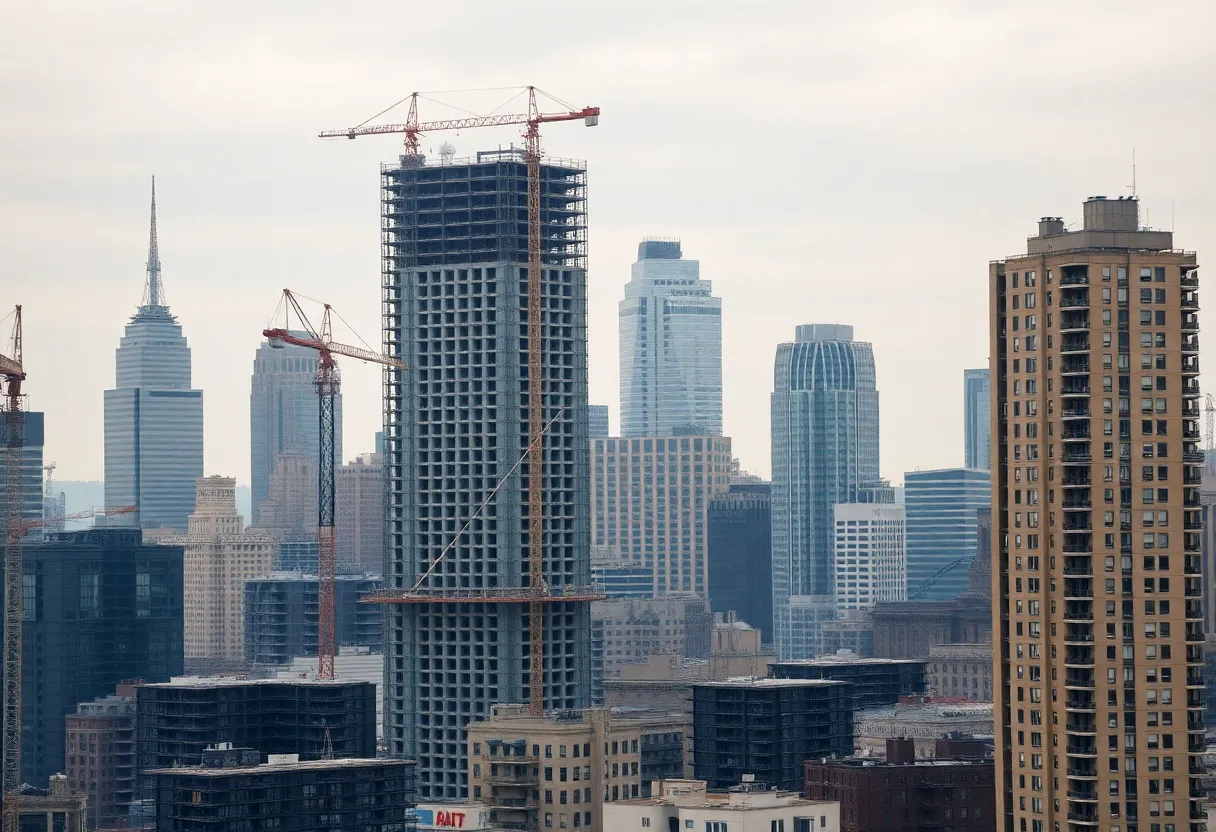New York City, October 6, 2025
News Summary
New York City has seen a sharp decline in new market-rate apartment construction, with quarterly housing starts falling from 7,500 to 2,500 units — a 67% decrease. Units under construction dropped from 71,000 to 47,000, driven by the replacement of the 421a tax abatement with the stricter 485x program, higher land and union labor costs, and tighter wage rules. Developers are leaning into conversions (8,310 units in the pipeline) and renovating existing buildings. Rent growth remains 2.7%, while construction wages and input prices have risen, adding pressure on new ground-up projects.
New York City housing starts fall 67% as 485x replaces 421a; construction shifts, conversions and higher contractor pay reshape market
New York City has seen a sharp pullback in new apartment building projects this year after the tax-abatement program known as 485x replaced the prior 421a incentive. Housing construction starts for market-rate apartments dropped from an average of 7,500 units per quarter (2021–2024) to just 2,500 units per quarter this year. The change represents a 67 percent decrease in starts and coincides with a fall in units under construction from 71,000 to 47,000.
Why starts fell and what developers are doing instead
The new incentive program places stricter affordability requirements and more demanding wage standards on projects, making some developers reassess the financial case for building new market-rate units. Higher land costs and expensive union labor in New York City compound the effect. As a result, more capital is moving toward purchases of existing apartment properties and toward converting older office buildings into housing rather than breaking ground on fresh developments.
The total pipeline from office-to-residential conversions has become an important source of new housing. As of February, the city had 8,310 new housing units in the pipeline from conversions. Two large planned conversions account for a meaningful share: one proposal could create as many as 1,250 housing units in a single major tower, while another aims to produce 1,600 units by repurposing a large, formerly commercial campus.
Market pressure and investor behavior
The persistent high cost to build in the city and the changed incentive structure are pushing some investors to target existing market-rate assets, which can be a simpler path to returns than starting new developments. Rezoning can help expand options, but land constraints in the dense city limit long-term supply growth. Without stronger or more predictable incentives, developers are likely to look elsewhere or focus on acquiring existing buildings.
Political uncertainty is also a factor. Many developers are cautious ahead of the upcoming mayoral election and are watching potential policy shifts closely. In recent industry polling, 40 percent of real estate professionals cited government-related issues (such as wage requirements and an onerous permitting process) as the “top obstacle to development.” That sentiment is keeping some capital on the sidelines until there is more clarity about long-term rules and costs.
Effects on rents and inventory
Reduced construction starts are slowing apartment inventory growth. Inventory in the city grew by only 6 percent from 2020 to 2024, well below growth in many other U.S. cities. Average rent growth in the city this year was 2.7 percent, which is about double the national average, meaning constrained supply is contributing to continued rent pressure.
Contractors raise pay and benefits amid tight labor market
A separate industry study found that New York construction firms are increasing wages and expanding benefits to retain workers in a tight market. The study surveyed more than 200 contractors and reported an average wage increase of 12.4%. Firms are offering performance-based bonuses, profit-sharing retirement plans and enhanced training programs to attract and keep skilled labor.
The study also found that about 79% of companies now offer cash bonuses, and that over 90% of construction firms provide retirement plans, most often through profit-sharing models. Despite these moves, many firms reported having to pass higher costs to clients or delay projects. Overall and nonresidential input prices were reported as 0.8% higher than a year ago and sit more than 40% higher compared to February 2020.
Operational responses and challenges
Firms are investing in workforce development, flexible work options, and mental health resources. Many are also planning to adopt new tools such as artificial intelligence and operational efficiencies to offset rising wages. The study found that a majority of respondents were not taking advantage of available federal and state employment tax credits, with about 82% of respondents unaware of available federal and state employment tax credits. These credits could include the Work Opportunity Tax Credit, which can provide targeted benefits for hiring certain groups.
Projects also require specialized labor, and in some cases those workers have temporary immigration status, which creates compliance challenges for owners and developers. To keep safety and retention high, companies are investing in advanced safety monitoring systems and smart personal protective equipment.
Policy options and industry recommendations
One policy suggestion from industry analysts is to offer longer-term tax incentives if policymakers ask developers to deliver deeper affordability over time; extending tax breaks beyond 30 years could make projects more viable. Industry leaders also point to streamlining permitting and ensuring wage rules are clear and predictable as ways to bring hesitant capital back into new construction.
FAQ
Q: By how much did housing starts drop this year?
A: Housing construction starts for market-rate apartments dropped from an average of 7,500 units per quarter (2021–2024) to just 2,500 units per quarter this year.
Q: What percentage decrease in housing construction starts does that represent?
A: The drop from 7,500 to 2,500 units per quarter represents a 67 percent decrease in housing construction starts.
Q: How did the number of apartment units under construction change?
A: The total number of apartment units under construction in NYC fell from 71,000 to 47,000 in the referenced period, according to CoStar.
Q: How many new housing units are in the pipeline from conversions?
A: As of February, NYC had 8,310 new housing units in the pipeline from conversions.
Q: What major conversion projects are planned?
A: Major planned conversion: Apollo Global Management, SL Green Realty and RXR plan to convert 5 Times Square into as many as 1,250 housing units. Major planned conversion: Metro Loft Management and David Werner Real Estate Investments plan to convert the former Pfizer headquarters at 235 East 42nd Street into a total of 1,600 units.
Q: What did the industry study find about contractor wages and benefits?
A: The study found New York construction firms are ramping up pay and benefits to stay competitive in a tight labor market. Nancy Cox said wages have increased by 12.4% on average as labor shortages persist in the industry (per the study). The report also found about 79% of companies now offer cash bonuses and over 90% of construction firms provide retirement plans.
Q: What supply and rent effects are noted?
A: NYC rent growth is 2.7 percent this year. The decrease in construction starts is reducing NYC’s apartment inventory growth; Apartment inventory in NYC grew by only 6 percent from 2020 to 2024.
{
“@context”: “https://schema.org”,
“@type”: “FAQPage”,
“mainEntity”: [
{
“@type”: “Question”,
“name”: “By how much did housing starts drop this year?”,
“acceptedAnswer”: {
“@type”: “Answer”,
“text”: “Housing construction starts for market-rate apartments dropped from an average of 7,500 units per quarter (2021–2024) to just 2,500 units per quarter this year.”
}
},
{
“@type”: “Question”,
“name”: “What percentage decrease in housing construction starts does that represent?”,
“acceptedAnswer”: {
“@type”: “Answer”,
“text”: “The drop from 7,500 to 2,500 units per quarter represents a 67 percent decrease in housing construction starts.”
}
},
{
“@type”: “Question”,
“name”: “How did the number of apartment units under construction change?”,
“acceptedAnswer”: {
“@type”: “Answer”,
“text”: “The total number of apartment units under construction in NYC fell from 71,000 to 47,000 in the referenced period, according to CoStar.”
}
},
{
“@type”: “Question”,
“name”: “How many new housing units are in the pipeline from conversions?”,
“acceptedAnswer”: {
“@type”: “Answer”,
“text”: “As of February, NYC had 8,310 new housing units in the pipeline from conversions.”
}
},
{
“@type”: “Question”,
“name”: “What major conversion projects are planned?”,
“acceptedAnswer”: {
“@type”: “Answer”,
“text”: “Major planned conversion: Apollo Global Management, SL Green Realty and RXR plan to convert 5 Times Square into as many as 1,250 housing units. Major planned conversion: Metro Loft Management and David Werner Real Estate Investments plan to convert the former Pfizer headquarters at 235 East 42nd Street into a total of 1,600 units.”
}
},
{
“@type”: “Question”,
“name”: “What did the industry study find about contractor wages and benefits?”,
“acceptedAnswer”: {
“@type”: “Answer”,
“text”: “Nancy Cox said wages have increased by 12.4% on average as labor shortages persist in the industry (per the study). About 79% of companies now offer cash bonuses and over 90% of construction firms provide retirement plans.”
}
},
{
“@type”: “Question”,
“name”: “What supply and rent effects are noted?”,
“acceptedAnswer”: {
“@type”: “Answer”,
“text”: “NYC rent growth is 2.7 percent this year. The decrease in construction starts is reducing NYC’s apartment inventory growth; Apartment inventory in NYC grew by only 6 percent from 2020 to 2024.”
}
}
]
}
Key features at a glance
| Feature | Detail / Data |
|---|---|
| Change in quarterly starts | From 7,500 to 2,500 units per quarter |
| Percent decrease | 67 percent decrease |
| Units under construction | Fell from 71,000 to 47,000 |
| Conversions pipeline | 8,310 new housing units in the pipeline from conversions |
| Major conversion projects | Planned projects up to 1,250 units and 1,600 units respectively |
| Rent growth | 2.7 percent this year |
| Contractor wage increases | Wages increased by 12.4% on average (per the study) |
| Bonuses and retirement plans | About 79% offer cash bonuses; over 90% provide retirement plans |
| Input price change | 0.8% higher than a year ago; >40% higher vs. Feb 2020 |
| Awareness of tax credits | About 82% of respondents unaware of available federal and state employment tax credits |
Deeper Dive: News & Info About This Topic
Additional Resources
- Commercial Observer: NYC apartment construction plummets
- Wikipedia: Housing in New York City
- Crain’s New York: NYC construction jobs still below pre-pandemic levels
- Google Search: NYC construction jobs 2025
- Construction Dive: How New York contractors fight labor shortages
- Google Scholar: construction labor shortages New York 2025
- Law360: NY construction co accused of layoff without proper notice
- Encyclopedia Britannica: layoff
- Long Island Business News: Long Island construction job decline
- Google News: NYC housing starts 485x 421a
Author: Construction CA News
The CALIFORNIA STAFF WRITER represents the experienced team at constructioncanews.com, your go-to source for actionable local news and information in California and beyond. Specializing in "news you can use," we cover essential topics like product reviews for personal and business needs, local business directories, politics, real estate trends, neighborhood insights, and state news affecting the area—with deep expertise drawn from years of dedicated reporting and strong community input, including local press releases and business updates. We deliver top reporting on high-value events such as the Rose Parade, Coachella, Comic-Con, and the California State Fair. Our coverage extends to key organizations like the California Building Industry Association and Associated General Contractors of California, plus leading businesses in technology and entertainment that power the local economy such as Apple and Alphabet. As part of the broader network, including constructionnynews.com, constructiontxnews.com, and constructionflnews.com, we provide comprehensive, credible insights into the dynamic landscape across multiple states.




